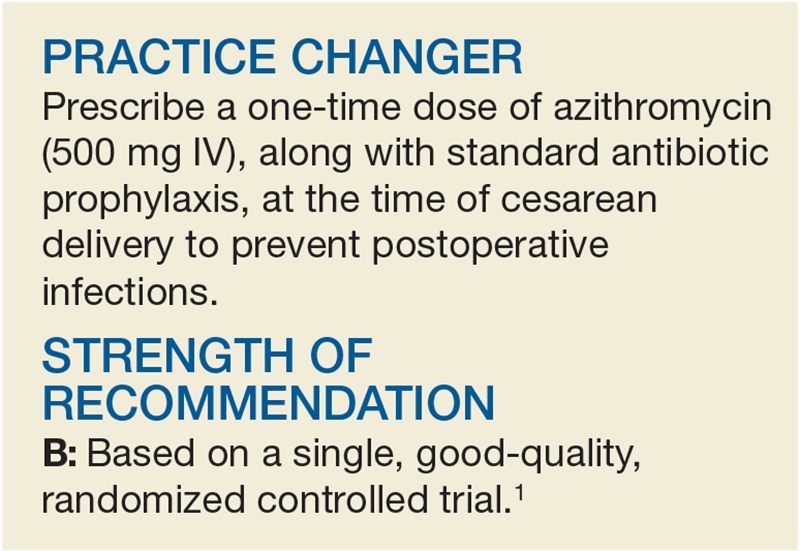A 26-year-old G1P0 at 40w1d presents in spontaneous labor and is dilated to 4 cm. The patient reached complete cervical dilation after artificial rupture of membranes and oxytocin augmentation. After four hours of pushing, there has been minimal descent of the fetal vertex beyond +1 station with significant caput succedaneum. Her physician decides to proceed with cesarean delivery.2,3 What antibiotics should be administered prior to incision to reduce postoperative infection?
The CDC reports that nearly 1.3 million cesarean deliveries were performed in the United States in 2015, which represents about a third of all births.4 C-section is the most common major surgical procedure performed in this country and is associated with an infection rate five to 10 times that of vaginal delivery.5,6 Pregnancy-associated infection, particularly during delivery, is a significant risk and the fourth most common cause of maternal death in the United States.5
The current standard of care in cesarean delivery is antibiotic prophylaxis (often a first-generation cephalosporin) prior to skin incision.7 The majority of c-sections performed are nonelective, and of these, postoperative infections occur in 12% of women who receive standard prophylaxis.8,9 A small, single-center design trial suggested that azithromycin adjunctive therapy expands antibiotic coverage to Ureaplasma species, resulting in a lower risk for postoperative infection.10
This study evaluated the use of azithromycin adjunctive therapy, in addition to standard antibiotic prophylaxis, to reduce the risk for postoperative infections in women receiving nonelective c-sections.
STUDY SUMMARY
Reduced infections up to 6 weeks post–c-section
A multicenter, randomized, double-blind trial conducted in 14 hospitals in the United States evaluated the effect of a one-time dose of azithromycin (500 mg IV) on postcesarean infections. Women with a singleton pregnancy of at least 24 weeks’ gestation were eligible for inclusion if they required nonelective cesarean delivery during labor or at least four hours after membrane rupture. Patients were excluded if they had a known azithromycin allergy, subsequent vaginal delivery, azithromycin use within the week prior to randomization, extensive hepatic or renal dysfunction, a known history of prolonged QT interval, or substantial electrolyte abnormalities. Patients were eligible even if they were receiving other antibiotics for a positive group B Streptococcus screening.1
All patients (N = 2,013) were treated with standard antibiotic prophylaxis (most often cefazolin), according to individual institution protocols. The women were randomized to receive either an azithromycin 500 mg/250 mL IV infusion (n = 1,019) or an identical placebo IV infusion (n = 994) within one hour of the procedure. The primary outcome was a composite endpoint of endometritis, wound infection, or other infections occurring up to six weeks after the c-section. Secondary outcomes included neonatal death, sepsis, and other neonatal and maternal complications.1
Patients in the placebo group had a higher rate of smoking during pregnancy; the researchers found no other significant differences.1
Results. The primary composite outcome occurred less frequently in the azithromycin group than in the placebo group (6.1% vs 12.0%; relative risk [RR], 0.51; number needed to treat [NNT], 17). When the researchers looked at the individual elements of the primary composite outcome, two had significant reductions versus placebo. Endometritis (3.8% vs 6.1%; RR, 0.62; NNT, 43) and wound infections (2.4% vs 6.6%; RR, 0.35; NNT, 24) occurred significantly less frequently, but there was no difference for other infections (0.3% vs 0.6%; RR, 0.49).
Serious maternal adverse events were also lower in the treatment group than in the control group (1.5% vs 2.9%; RR, 0.5; NNT, 71). There was no difference in composite secondary neonatal outcomes, including death and serious complications (14.3% vs 13.6%; RR, 1.05).1


